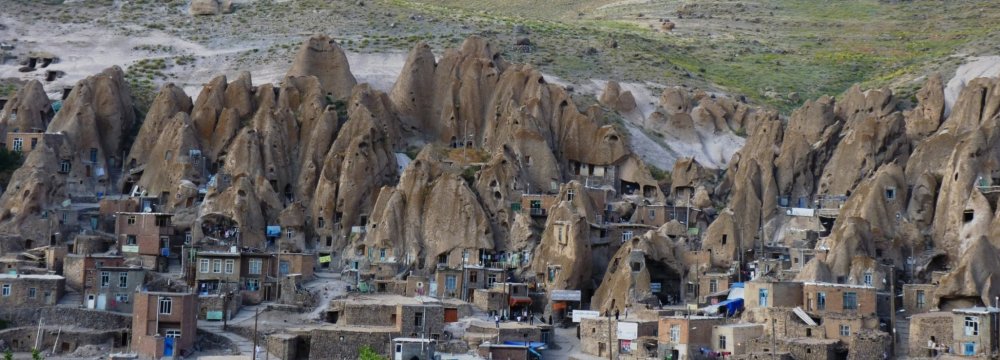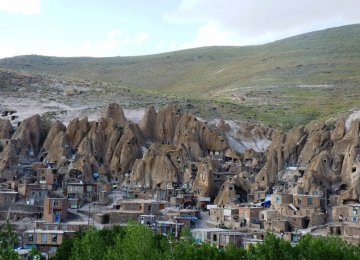Kandovan is a village in Sahand Rural District, in the Central District of Osku county, East Azerbaijan Province, Iran. This village is a wonderful example of manmade cliff dwelling which is still inhabited. in the 2006 census, the village population was 601, from 168 families, according to Aryazamin website.
The troglodyte homes, carved into volcanic rock and ash to dwellings in the Turkish region of Cappadocia, are locally called “Karaan”. Karaans were cut into the Lahars (volcanic mudflow or debris flow) of Mount Sahand.
At first glance the landscape of the village contains erratic sharp-pointed cones with holes in them. The cone form of the houses is the result of lahar flow consisting of porous round and angular pumice together with other volcanic particles that were positioned in a grey acidic matrix. After the eruption of Sahand these materials were naturally moved and formed the rocks of Kandovan. Around the village the thickness of this formation exceeds 100 meters and with time due to water erosion the cone shaped cliffs were formed.
The Kandovan dwellings mostly date back to the 13th century AD and in some cases to pre-Islamic era. It exemplifies the primitive coexistence of human with nature.
History
The term “Kandovan” refers to the architecture of the houses as they share a similar form with bee hives, called “Kandoo” in Persian.
It has been said in the history of Kandovan that the first group to settle in the region were residents of a village called Hilevar, 2 km away from Kandovan. They migrated to the area escaping from Mongols and started to carve the Karaans to build themselves a safe refuge.
The Village
The beautiful spas of the village are an excellent place for patients with renal problems to enjoy a natural therapeutic experience. Besides, the silence and tranquility of the mountains along with the clean air draw numerous artists to the spot every year.
The fruitful plains of the region provide nomads with a possibility to breed honey bees and grow medicinal herbs, both sources of income for the locals. Handicrafts such as weaving of Kilims, and colorful scarves is among the occupations of Kandovan women.
The village has a mosque, public bath, school, and a mill. The mosque Karaan is one of the biggest karaans of the village.
The Interior of the Karaans is neat and simple. Each contains rooms, depending on the owner’s wealth, decorated with niches, curtains, and cushions (Persian: Poshti). Houses have several stories; the first is for animals and the rest for the family to live in. Kandovan, like other villages on hills, keeps the staircase form with narrow steep alleys. Residing in the heart of the rocks brings about your living place to be cool and desirable in the summer and warm and cozy in the winter. However, Kandovan has almost a long winter and its tourist season starts from spring and lasts only until early fall.
The Rock Hotel
The Tulip (Persian: Laleh) International Rock Hotel in Kandovan which is the third hotel of the kind in the world offers the tourist from all around the world the chance to have an enjoyable trip to the region.
The hotel is designed to have 40 Karaans (natural rock rooms), 10 of which are now available with complete room service and Jacuzzi. They are all equipped with heating system for the winter. In the summer the hotel does not need cooling system as the weather is very pleasant in Kandovan. A luxurious restaurant with a variety of Iranian and foreign dishes ready to host 120 people are among other facilities of the hotel. It is to be expanded by adding other 30 Karaans and more facilities such as commercial center, swimming pool, and parking.
The project of Tulip hotel in Kandovan started in 2006 by Iran Tourism Development Corporation.





